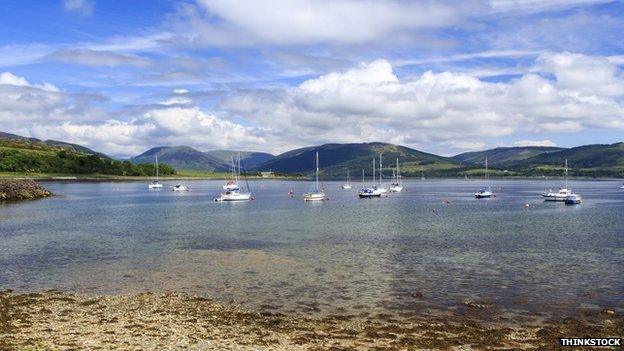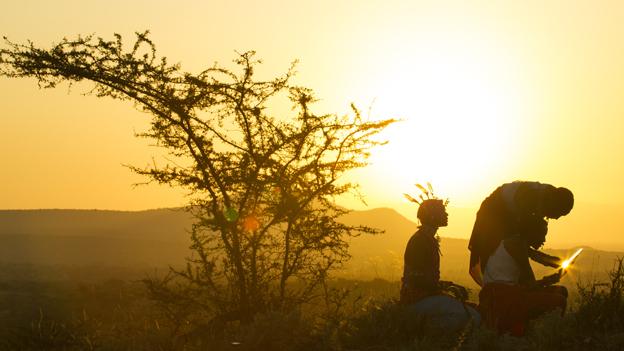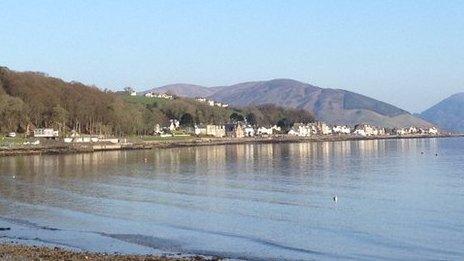White space between TV signals could save lives at sea
- Published
What is white space technology?
The leftover white space between TV signals is raising the hope of saving lives at sea and proving broadband for remote communities.
"Come in, Solent Coastguard..." It is the third time the coxswain of the Freshwater independent lifeboat, Jeremy Blake, has tried to get through. He is using VHF radio, a technology virtually unchanged for a century.
It was from the cliffs above Freshwater Bay on the Isle of Wight that Guglielmo Marconi first proved that radio could be used for two-way wireless communication with ships at sea.
In the years since Marconi began his experiments in 1897, marine radio has saved countless lives but is far from perfect.
"Essentially we're using the same technology," says Mr Blake. "It's got smaller and more reliable but we're still limited by line of sight. We can only have one-way communication at a time, and if someone else is talking on the radio that will drown us out if they've got a stronger signal.
"So sometimes we can't communicate. We often have problems when someone is sitting on their radio, and transmitting, and they are blocking out all the other channels."
'Prime real estate'
That could all be about to change. The lifeboat has been taking part in a trial of a new technology that supporters say could not only save lives but bring superfast broadband to rural communities that so far have been cut off from the information age.
It is called TV white space and takes advantage of unused parts of the spectrum reserved for television transmissions.

Jim Beveridge, of Microsoft, says the use of white space could transform the lifeboat's communications
"This is prime spectrum real estate," says Jim Beveridge, of Microsoft, who ran the Freshwater trial.
"The broadcasters weren't stupid. They put their transmitters in the place that gave them best coverage for the lowest possible power to reach the maximum number of viewers."
That is the reason this part of the spectrum is tightly regulated - you need a licence to broadcast on these frequencies. But there is lots of unused room here, either sections left intentionally blank to act as a buffer between the TV signals or space left behind when services went digital.
So what could this do for the lifeboat? Mr Beveridge is clear that it could transform communications for its crew.
"It could give them voice, it could give them video, and in the future it could also send information from medical machines back to base, so if there's an emergency at sea you can send that information back, so they know what to expect," he says.
Constantly updated
White-space technology is possible because of advances in many areas of science - but the most important is GPS.
Any device designed to use the vacant parts of the spectrum has to know where it is, and then can refer to a constantly updated database to find out which frequencies are available and at what power.
Prof Robert Stewart, of the Centre for White Space Wireless Communications, external at the University of Strathclyde, says it is all about the more efficient use of finite resources.

Strathclyde University has used white space to bring broadband to the Isle of Bute
"If I went down to Manchester, the TV multiplex will be in a certain band of frequencies, and we won't use that band of frequencies in Glasgow or Newcastle or other parts of the country," he says.
"But if they are using something in Manchester for broadcasting on, we're not going to interfere with it here in Glasgow if we pop up a very low-level signal and use the spectrum that is otherwise unused."
Prof Stewart says the technology works and is far cheaper than current options, such as running miles of expensive cable. It is already up and running in the US and Singapore.
Strathclyde University has worked with partners including BT and the BBC to bring superfast white-space broadband to the Isle of Bute in the Firth of Clyde.
Broadband obstacles
David Grossman looks at the potential of TV "white space" technology
Isle of Wight broadband provider Click4Internet currently uses 5GHz wi-fi signals to beam the internet to remote houses.
Chief executive Fraser Munro says: "Right now we use radio transmissions to overcome the problem of people in rural areas who have very long or very old telephone lines. Broadband simply won't travel down the old copper lines very well.
"So we put a receiver on their roof and we transmit their broadband through that receiver. The problem with the current broadband we use is that it doesn't go through obstacles like trees or walls very well, so if someone lives in a very wooded area it's very difficult for us to reach them. The new white-space technology, because it's a lower frequency, will allow us to penetrate trees to go through walls."
So what's stopping this revolution?
Ofcom, which regulates the broadcast spectrum, has authorised the trials but would need to allow the white spaces to be used fully. While it is extremely enthusiastic about making the technology work, Ofcom has to be sure it will not interfere with the TV signals.
Phillip Marnick, head of the spectrum policy group at Ofcom, has told Newsnight he expects white-space technology to be legal in Britain from next year.
- Published1 July 2014

- Published5 February 2013

- Published29 March 2012
- Published29 March 2012

- Published7 July 2011